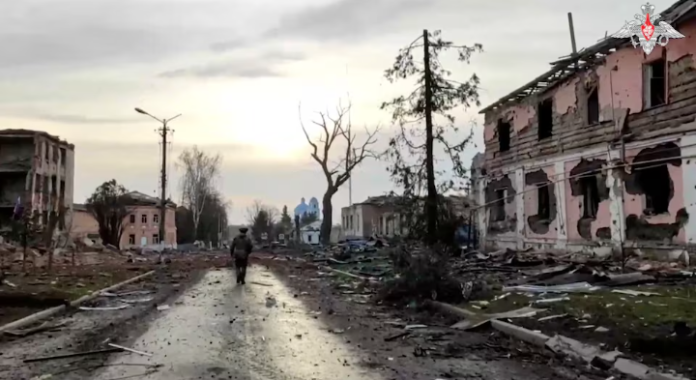In a significant escalation of the ongoing conflict, Russian forces are intensifying efforts to expel the last Ukrainian soldiers from the western part of Russia’s Kursk region. This development follows a bold seven-month incursion by Ukrainian troops, aiming to divert Moscow’s military focus and gain strategic leverage.
Ukrainian Incursion and Russian Counteroffensive
Last August, Ukrainian forces launched an unprecedented offensive, crossing into Russia’s western border in the Kursk region. This marked the most substantial breach of Russian territory since World War II. Initially, Ukrainian troops controlled over 1,368 square kilometers (528 square miles). However, recent Russian counteroffensives have reduced this area to approximately 110 square kilometers (42 square miles), according to open-source intelligence.
Prominent pro-Russian military analysts report that Russian forces have pushed Ukrainian troops back to the border in certain sectors. Despite these setbacks, Ukrainian forces continue to mount fierce resistance as they retreat. Battlefield reports indicate that Russia is actively clearing extensive minefields in the contested areas.
Leadership Changes and Strategic Implications
Amid these developments, Ukrainian President Volodymyr Zelenskyy appointed Andrii Hnatov as the new Chief of the General Staff of Ukraine’s Armed Forces, replacing Anatoliy Barhylevych. This leadership change aims to bolster Ukraine’s military effectiveness in response to the challenges in the Kursk region and escalating pressures in Donetsk.
The appointment underscores Kyiv’s commitment to adapting its military strategy in the face of evolving battlefield dynamics. Despite the adverse situation in Kursk, Ukrainian forces have stabilized other fronts, particularly near Pokrovsk, and have tested domestically produced long-range missiles to enhance their defensive capabilities.
Ceasefire Prospects and International Involvement
The intensifying conflict has prompted international efforts to broker a ceasefire. European and Commonwealth nations, including Britain, France, Canada, and Australia, are moving towards an “operational phase” to support Ukraine in achieving a 30-day unconditional truce, as proposed by the United States. Discussions emphasize the necessity of robust military backing and monitoring mechanisms to ensure a sustainable peace agreement.
Russian President Vladimir Putin has expressed conditional support for the U.S. ceasefire proposal, stating that any cessation of hostilities must address the fundamental causes of the conflict to ensure lasting peace. These conditions include Ukraine renouncing its NATO aspirations and acknowledging Russian control over certain territories.
Humanitarian Impact and Casualty Reports

The protracted conflict has resulted in substantial casualties and humanitarian concerns. U.S. intelligence assessments estimate that combined Russian and Ukrainian military casualties could be as high as 354,000, underscoring the war’s devastating toll. Additionally, the involvement of North Korean troops fighting alongside Russian forces in the Kursk region has been reported, although specific details remain undisclosed.
Outlook and Future Developments
As Russian forces intensify operations to eliminate Ukrainian presence in the Kursk region, the conflict’s trajectory remains uncertain. The resilience of Ukrainian troops, coupled with strategic leadership changes and international diplomatic efforts, plays a crucial role in shaping the next phases of this multifaceted war. The global community continues to monitor the situation closely, advocating for a resolution that ensures regional stability and addresses the humanitarian crisis resulting from the prolonged hostilities.



